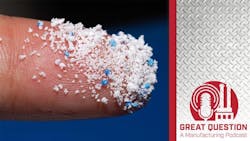Podcast: How Air Sealing Technology Reduces Scrap in Plastics Manufacturing
Key Takeaways
- Why reducing scrap is the starting point for sustainability in plastics production
- The inefficiencies and contamination risks tied to traditional packing seals
- New technology offers a non-contact, low-maintenance alternative
- Why most manufacturers haven’t adopted this sealing approach—yet
Scrap reduction isn't just a quality issue—it's a sustainability imperative. In this episode of Great Question: A Manufacturing Podcast, Laura Davis, editor-in-chief of New Equipment Digest, talks with Cody Kaufmann, business development manager at SEPCO, about how its new air seal technology is helping plastics manufacturers cut waste, improve uptime, and move closer to their environmental goals. Learn how one facility reduced scrap by 99% and why plant managers should rethink the role of sealing systems in efficient, sustainable operations.
Below is an excerpt from the transcript:
LD: Of course. So to start off, when you look at plastics manufacturing in this environment, especially in film and packaging, what are some of the biggest sustainability issues that tend to jump out at you?
CK: Yeah, I mean, I think the biggest sustainability issue—well, really, the top two—are scrap and waste. They're not only the biggest issues within plastics manufacturing, but really the biggest issues that even consumers face with plastics. I'm sure your listeners are well aware of all the legislation and the things happening around banning plastic straws, cups, bags, and those kinds of things, which show that there is a scrap and waste issue with plastic consumer products, but that also certainly connects to the manufacturers. So when we're considering plastics manufacturing, that’s the biggest downside, I guess you could say, of plastics manufacturing. What do we do with all the scrap? And what do we do with all the waste? So that is certainly the biggest issue—scrap and waste with respect to the plastics manufacturing issue we’ve got to address.
LD: Yeah, you know the fact that it's such a big issue. It seems like most manufacturers kind of just live with scrap and waste in their plants, and maybe don't realize how much of an issue it is. So, could you speak on how big of a problem it really ends up being for people?
CK: Yeah, sure. I think much of the time in manufacturing, specifically with plastics, but I think this is probably true with any manufacturing, scrap and waste are really just assumed to be a part of the process. The average kind of cost of scrap and waste in the process is just kind of built in. And just so long as those rates don't exceed that cushion that's kind of built in, everyone's happy. But I think when it comes to plastics manufacturing, I think the problem has been—and still is, to some degree—that we're really only just now realizing the ramifications of what plastic scrap and waste are doing. Not just the environmental impact, but the health and safety impact, the efficiency and manpower impact to dispose of that scrap and waste, to do something with it. And even the impact of producing that scrap and waste. And it sounds kind of funny to say you're producing scrap and waste, but anytime you're making something, if what you're making happens to be scrap and waste, you're actually utilizing resources to produce something that's never going to actually be used. I think it's going to always be a problem with manufacturing, that is, scrap and waste, but specifically with plastics manufacturing. It has been something that manufacturers have just been living with. But I think we are starting to realize how big of a problem it actually is.
LD: Yeah, it's really interesting. And you kind of touched on this, but the fact that so many are just living with it, why is this problem something that just seems to fly under the radar for plants? Why are people just living with it? And if a facility is dealing with it at all, what is a traditional method or resource they're using to prevent scrap and waste?
CK: So, a couple of reasons why I think it does fly under the radar a little bit. And I think the FIRST of those is the fact that it's kind of a bottom line issue. It hasn't really, in the past, and maybe currently, doesn't hurt quite enough financially for them to deal with it. So if it doesn't hurt, then it kind of just flies under the radar a little bit. But secondarily, I think we haven't really cared enough to address it, right? And so there are some recycling programs that companies have put in place, and there are some ways that companies are trying to reuse the scrap that they're producing. But that being said, a lot of it still does just get thrown away. So, I think it flies under the radar, because again, it doesn't hurt quite enough, which is something that we're trying to address. And I think we'll talk about that a little bit. But also just the cultural issues of trying to make us care about scrap and waste. So those are the reasons.
About the Podcast
Great Question: A Manufacturing Podcast offers news and information for the people who make, store and move things and those who manage and maintain the facilities where that work gets done. Manufacturers from chemical producers to automakers to machine shops can listen for critical insights into the technologies, economic conditions and best practices that can influence how to best run facilities to reach operational excellence.
